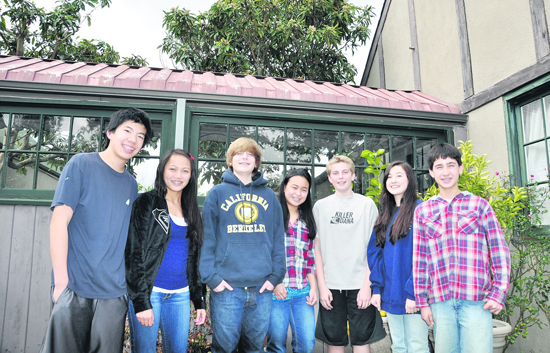
| ||||||
Meet the Odyssey team led by the courageous Linda Wong. Involved in the international program that allows students to creatively solve open-ended problems, then compete on national and world levels for prizes, these six 8th-graders from Joaquin Moraga Intermediate School are boisterous, bright and bound for glory. But they need to hustle as the San Francisco Bay Regional Tournament is February 27th and the team is behind schedule. "This is extreme even for us," says Dana. "The last few weeks before the competition are intense," admits Garcia. "One good idea is better than a lot of sort of good ideas," says Boozarpour, demonstrating a key skill for excelling in the Odyssey realm: perseverance.
Group leader Wong, a scientist by profession and by nature, itemizes the learning: the six kids are friends, the girls are comfortable using power tools, and they all know it's a good idea to make a prototype before building the final product-especially important for this year's team, who like to think BIG. And outside the norm. "He's very other-thinking," Wong says about her son Tom, the word man in the group. The same might be true for any number of kids, if schools were designed for innovation. "I thought that school was teaching for tests," Wong says. Providing "other-thinking" experiences for her children and her teams has kept her at the Odyssey leadership post for the past six years. "Kids, just like adults, are reluctant to change," she says, "but through Odyssey, they find out how adaptable they really are."
Selecting the problem the team will solve is the first test of group flexibility. "We kind of say which ones we don't want to do first," says Adachi. They chose the Discovered Treasure problem, requiring a portrayal of the discovery of two treasures: an actual historical treasure and a modern sculpture or structure that currently exists, but is discovered in the future.
Team brainstorming style is next: "Most of the times our ideas just come-they're spontaneous-" begins Price. But Tom, wanting to get it just right, jumps in before he can finish: "Someone submits an idea, everybody yells 'No!' Then five minutes later, we actually think about it." It's exactly this; this messy, loud, overlapping, nearly slap-stick communication that is the heartbeat of Odyssey. Because in the end, life is more about "sponts" than about tests.
"Sponts," the nickname the team uses for the spontaneous component of the competition, cause a flurry of excitement. They surge forward with enthusiasm, clustering in a tight group, all talking at once. Then, suddenly self-aware, the team falls silent, until Garcia sums up the obvious truth: "At school you have to worry about grades and what people think about you. Here, you just work together and have fun."
To learn more about Odyssey of the Mind, visit the website at www.odysseyofthemind.com
Reach the reporter at:
Copyright
